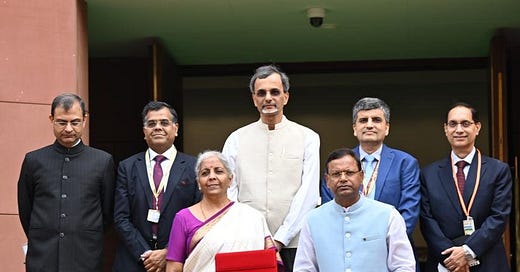Analysis of the Fiscal Deficit in the Budget Estimates for 2024-25
The Budget Estimates for 2024-25, as presented, offer a detailed financial roadmap for India's fiscal management. The speech itself spanned 62 pages and the regular media, as well as social media, have been splattered with figures which make it difficult even for an informed reader to make any reasonable inferences or opinion. We shall, however, delve deep into the Budget documents to present a subject-by-subject analysis of the various perspectives of the Budget, since it is not possible to cover everything meaningfully in one article. This piece is devoted to the all-important parameter of the fiscal deficit.
It is noteworthy that the overall borrowing is less than the previous year and that the fiscal deficit at 4.9% of the GDP, although moderately high, is well on track to achieve an even better parameter of 4.5% next year. Here's an analysis with reference to the income and expenditure and the corresponding borrowings required to meet the deficit, as culled out from the Finance Minister's Budget speech.
Key Figures and Estimates
Total Receipts and Expenditure:
Total receipts other than borrowings: ₹32.07 lakh crore
Total expenditure: ₹48.21 lakh crore
Net tax receipts: ₹25.83 lakh crore
Fiscal Deficit:
Estimated at 4.9% of GDP for 2024-25.
Market Borrowings:
Gross market borrowings through dated securities: ₹14.01 lakh crore
Net market borrowings: ₹11.63 lakh crore
Both figures are lower than the previous fiscal year (2023-24).
Fiscal Policy and Consolidation
Commitment to Fiscal Discipline:
The FM reiterates the commitment to the fiscal consolidation path announced in 2021, which has been beneficial for the economy.
The goal is to reduce the fiscal deficit to below 4.5% by the next fiscal year.
Long-term Debt Strategy:
From 2026-27 onwards, the aim is to ensure that the Central Government debt as a percentage of GDP will be on a declining path.
Analysis
Revenue and Expenditure Balance:
The significant gap between total receipts (₹32.07 lakh crore) and total expenditure (₹48.21 lakh crore) indicates a substantial fiscal deficit.
The net tax receipts of ₹25.83 lakh crore suggest an optimistic projection of tax revenue, potentially relying on economic growth and effective tax administration.
Fiscal Deficit Management:
At 4.9% of GDP, the fiscal deficit reflects the government's continued reliance on borrowing to finance its expenditure.
The target to reduce the deficit below 4.5% by the next fiscal year indicates a cautious approach towards fiscal consolidation.
Market Borrowings:
The reduction in both gross and net market borrowings compared to the previous year signifies a prudent borrowing strategy.
This approach could help in controlling interest payments and managing public debt levels more effectively.
Long-term Fiscal Health:
The commitment to maintaining the fiscal deficit on a downward trajectory and reducing the Central Government debt as a percentage of GDP from 2026-27 is crucial for sustainable economic growth.
This long-term vision is essential for maintaining investor confidence and ensuring fiscal stability.
In Summary
The Budget Estimates for 2024-25 reflect a balanced approach towards managing fiscal deficit while ensuring necessary expenditure for development. The government's commitment to fiscal consolidation and a strategic reduction in market borrowings indicate a responsible fiscal policy. However, achieving these targets will require robust economic growth, efficient tax collection, and prudent expenditure management. The focus on reducing the fiscal deficit and managing public debt sustainably is commendable and crucial for India's long-term economic stability.




